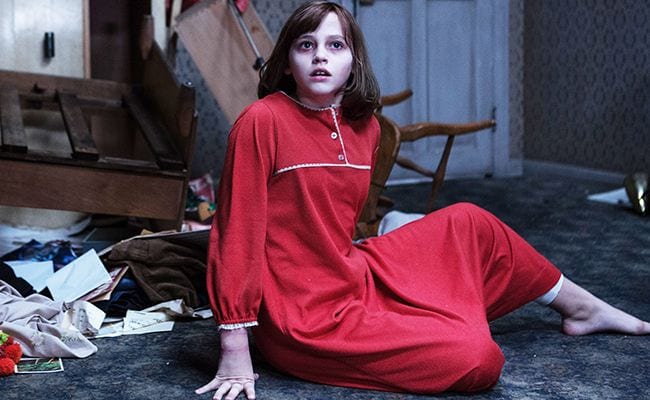
“You were caught smoking.” As she confronts her 11-year-old daughter, Peggy Hodgson (Frances O’Connor) is the very picture of exasperation, her shoulders simultaneously squared and stooped, her face weary and determined. Surrounded by the dreary, cracked walls of their North London council flat, young Janet (Madison Wolfe) looks up at her mother, at once defiant and afraid. “I’m not lying,” she insists.
Peggy doesn’t believe her. The headmistress has called, she tells Janet, and reported that she caught Janet with a cigarette in hand. But you do believe Janet, because you’ve seen the events at school that the headmistress misunderstood. You also know, because you’re watching a movie called The Conjuring 2, that as soon as Janet and her older sister Margaret (Lauren Esposito) pull out a spirit board to ask whether anyone might want to contact them, that they will be contacted and moreover, that adults in the vicinity will continue to misunderstand events.
You know too, that Janet, so earnest and so distressed that her mother won’t believe her, will be the visiting spirits’ primary target, soon enough speaking in a scary man’s voice, turning increasingly pale, and twisting her limbs into impossible positions.
As this target, Janet is pretty perfect and utterly familiar. Based on a 1977 case that involved the Warrens, real life evangelical ghost hunters who became popular following their work on the Amityville horror, and souvenir collectors, The Conjuring 2 at first cuts back and forth between the haunted flat in Enfield and Ed (Patrick Wilson) and Lorraine (Vera Farmiga), back in Connecticut. Though they’ve already appeared in The Conjuring, the film reintroduces them here, in Amityville, engaged in the very case that made them famous.
However you know Amityville, through the books or the many films and TV iterations, including the 1979 movie with James Brolin and the the 2005 movie with Ryan Reynolds, you know it. That is to say, you know the DeFeos met a bad end when they didn’t leave their sinister house in New York.
Here you see that end again, as Lorraine, clairvoyant, channels the killer and walks room to room, cocking and firing an invisible shotgun at family members in their beds. (She also sees a “Demon Nun” [Bonnie Aarons], whose reappearance throughout the film implies Lorraine has her own special haranguer, not tied to a place.) The DeFeo business an undeniably chilling evocation: when Lorraine passes a mirror, you see the bearded Butch DeFeo, the two figures locked in a wholly ghastly version of the Harpo-Groucho Marx mirror gag.
Lorraine’s performance here serves as a mirror for you as well, as she watches herself, appalled and abject, consumed by the image. By the time she finds herself back at the table downstairs, next to Ed and dissolved in tears, you’re well aware that this work they’re doing, the part that you do with them, which is to witness monstrosity, has costs. Lorraine and Ed, of course, believe their work has another part, the saving part, bringing their Christian faith to bear against demons. Thus, when they get the call from Enfield, as you know they will, they go, no matter Lorraine’s reluctance to meet and be filled with yet another terror.
As strongly as they do believe, Ed and Lorraine arrive at Peggy’s home full of skepticism, per the formula of such movies. Lorraine is especially uncertain because, as she puts it, she doesn’t “feel anything”. Ed, for his part, embraces the family, including Janet’s little brothers, all worn out from a few weeks of media coverage and lack of sleep, with furniture moving about and other kids taunting them at school. Sporting Elvis-like sideburns and singing an Elvis tune (a mostly charming “Can’t Help Falling in Love with You” directed at Lorraine — that is, the camera — who stands in a doorway, pensive and sad, while the family gathers round him), Ed is so expansive and so warm, you’re hoping he’ll believe Janet, even if no one else does.
Whether or not Ed and Lorraine do believe her becomes a central question, and The Conjuring 2 doesn’t so much solve it as it speculates on how we believe or don’t believe. A German doctor named Anita (Franke Potente) provides the full range of skeptical responses, rolling her eyes, muttering counter-commentary, setting up hidden cameras to catch fakery. As much as you might appreciate Anita’s rationality and disbelief, you’re also inclined to believe, having made an investment in the movie’s seeming premise, not to mention director James Wan’s manifest love for his material.
In this doubled position, knowing you shouldn’t believe but maybe wanting to believe, you’re a little like Lorraine and Ed. They have reputations to preserve, now that they’re celebrity ghost busters, but they’re also true believers in the most religious sense. A conversation Lorraine has with Janet, as they sit on shabby swings in the haunted house’s backyard, is more mesmerizing and disturbing than the big effects scenes, suggesting ideas that most scary movies don’t spend much time on. The camera frames them closely, their faces drained by the anguish they’ve felt and the trust they want to share but can’t quite.
So quiet and so unusual, the moment distills what’s at stake for both Janet and Lorraine, both feeling too much and unable to maintain borders between times and bodies. You might even believe, for this instant, that when Lorraine shares her story of hope, that Janet can seize on it, despite everything that’s telling her not to. But then the movie kicks back into gear, a series of regular horror movie mechanics, with people walking into rooms they shouldn’t and doors banging and figures slamming into walls.
The movie is what you expect, after all. You don’t have to believe any of it.


![Call for Papers: All Things Reconsidered [MUSIC] May-August 2024](https://www.popmatters.com/wp-content/uploads/2024/04/all-things-reconsidered-call-music-may-2024-720x380.jpg)



